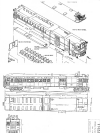One of the most asked-about cars on the TH&B was gas-electric (aka "doodlebug")
number 301. This is a brief look at the car from the point of view of the modeller,
with a rough sketch by John Spring (based on the Bachmann instruction diagrams)
showing the kitbash of the Bachmann Spectrum HO scale model. This model has
gotten mixed reviews from the opinionated bunch on the various mailing lists
and usenet newsgroups. The bottom line seems to be that Bachmann's quality control
is variable: always test-run a Spectrum model before you buy.

 |
This photo dated 1936, from the Keith Sirman collection,
shows 301 in pristine condition passing under the coaling tower at Chatham
St. in Hamilton. |

 |
This photo provided by Keith Sirman, shows car 301 at
Waterford, Ontario in 1938 or 1939. |

 |
This undated Keith Sirman collection photograph, is probably
a builder's photo before they airbrushed the background out. (I expect to
be corrected about the actual technique used in the 1920's, but you get
the idea.) |

 |
This graphic shows the basic changes to the shell of
the Bachmann Spectrum Gas-Electric model in HO scale (rumours abound that
an N scale version will be developed in 1998). Basically, you need to reduce
the length of the body by a total of 12 feet by taking out a portion just
behind the cab and another portion including the front-most passenger window.
This will give you a shell which is reasonably close to the prototype length,
but leaving as much of the moulded-in detail in place as possible. The detailing
on the roof above the cab differs from the stock model, so you'll need to
make some modifications (use the photos above, or better yet, purchase prints
which show the exact view you need). The front of the cab must be reconstructed,
either by using scratchbuilt parts or by scavenging for a larger scale automotive-style
grille (John Spring is following this direction). Other changes you may
want to make, depending on how accurate you intend to be, include moving
the rear truck closer to the end and reshaping the roofline to more closely
match 301. |



